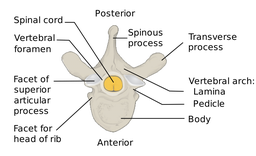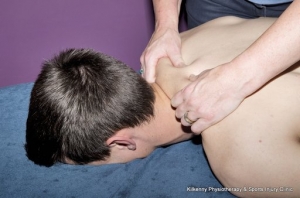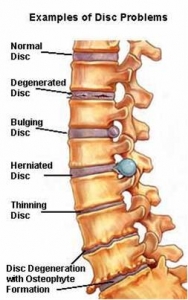Neck Pain
Although neck pain is one of the most common musculoskeletal problems, few people actually seek help. Because you can still walk and function, people will often put neck ache on the long finger. They often don’t realise that treatment is at hand, and that it can hugely improve their quality of life.
Anatomy
Each vertebrae (bone) in the spine is made of a body at the front. These are the weight bearing parts of the bone, and they are separated by the discs. At the back of each vertebrae is a space (the spinal canal) through which the spinal cord passes.
Behind the main body of the vertebrae there are two little joints (facet joints) which lie at an oblique angle, making them ideal for movement but not for weight bearing.
Discs are found between the bones of the spine and act as shock absorbers of the spine. They are made up of a jelly like centre (the nucleus) surrounded by tight criss-crossing diagonal bands (the annulus) that attach to the bones above and below.
The nucleus of the disc could be likened to a ball bearing in that it acts as a medium between two solid structures (the vertebrae bones). They allow movements in all directions between the bones, while the ligaments and muscles keep the alignment of these bones.
Possible causes of Neck Pain
Neck Pain may be divided firstly into categories:
- Acute Neck Pain: usually occurs following an accident, incident or sudden movement, or a prolonged sustained posture such as sleeping awkwardly.
- Chronic Neck Pain: The sufferer may have this for a period of months or years. This could be caused by sedentary lifestyle, poor posture and muscle imbalances, repetitive sports or activities, structural problems etc.
- Acute on Chronic Pain: Where the sufferer has a flare up of a chronic or previous neck pain.
Any of these may be associated with referral of pain or peripheral symptoms such as headaches, jaw or face pain, forearm or elbow pain.
Types of Neck Pain
Any of the following can be the structure which causes your neck pain or ache, if it is due to a mechanical cause.
- Discs
- Facet joints
- Ligaments
- Muscles
- Nerves
- Fascia
It may also be a combination of several of these.
Discs
Although disc injuries are more common in backs, they can also occur in necks. If the spinal cord is severely distorted at this level, it can effect the upper and lower limbs. This is why accurate diagnosis and care during treatment is essential. Care must be taken when treating necks, which is why a chartered physiotherapist is your best option.
Most people have poor upper body posture. Most commonly we see people with their head in front of their body instead of on top of their spinal column. As a result, some of the discs in the neck can bulge backwards. This may cause the nucleus to bulge towards the back of the spine.
Over a period of time this bulge may increase so that it presses on the neural structures in the spine, and this will cause local pain. This may happen gradually after a period of prolonged bending forward, for example leaning over a desk.
However, a more common cause of disc pain is as a result of a sudden jerk forward or to the side, causing immediate damage to the disc.
![]()
Symptoms
- Difficulty or inability to bring the neck into line
- Pain on cough or sneeze
- Pain eased by supporting the head
- Worse in morning
- Aggravated by certain movements
- Symptoms in the shoulder or arm
Treatment
The early treatment:
- Ice
- Lying flat on your back with your head supported
- Analgesics can useful until the acute bulge settles a little
However, it is important to seek physiotherapy assessment and treatment early.
Although the majority of these discs do settle spontaneously it is still important to contact a chartered physiotherapist at this stage. On top of treating the disc, we will give advice on how to reduce the risk of recurrence. Even if this is your first episode, it may be well be the beginning of a cycle and it is important to try and reduce this.
If you do, or have already entered the cycle of recurrent disc bulges you will find that they tend to get more severe and last for longer each time. This is because the damage to the annulus increases with each episode, making subsequent bout of back pain worse.
Herniated Disc
If the nucleus in the centre of the disc bulges out through the annulus, then you have a herniated disc. This is often incorrectly referred to as a “slipped disc”.
If the nucleus of the disc actually protrudes out through the annulus, then it is a ruptured disc. This will not respond to conventional treatment and surgery may be required.
Your GP or physiotherapist should refer you for an MRI scan if they suspect this, and referral to an orthopaedic or neurosurgeon should be considered.
Prognosis
The prognosis is very good but is dependent on a number of factors;
- The severity of the bulge
- The number of previous episodes
- The stage at which intervention is sought
- The ability of the patient to follow advice
- Lifestyle
“The Quick Fix”
When suffering from severe neck pain, people often want quick relief by whatever means possible. This leads to trying to find a “quick fix”, which more often than not only gives short term relief and may not get to the root of the problem. While your pain may resolve after one session, we may recommend that you do a couple of sessions, or even join a Pilates class to ensure we have treated the cause of your problem, and reduce the risk of it returning.
Let me give you an analogy.
Imagine you had a drawer at home that was a bit stiff and got stuck every now and then. Imagine that every time it’s stuck, you hit it a little kick. As a result, the drawer would open and close freely again; for a while. Eventually it would start to stick again and so you’d give it another little kick. And so on and so on, until one day you’d kick it and it falls apart.
Now, if you had taken that drawer out the first time it stuck, and looked for the reason why it stuck, and did something about that, then the drawer would move smoothly from then on.
Similarly, if every time you get a bulging disc you get it a “quick fix” and knock it “back into place”, then it will continue to bulge again. These episodes will start to happen more frequently and become more severe until one day the “quick fix” just doesn’t work anymore, and you may require surgery.
Now, the first few times you get a bulging disc, if you went and sought accurate diagnosis, advice and treatment, the cause of your specific bulging disc would be recognised. This may be any number of things, such as:-
- Weak muscles
- Too much movement at one segment of your neck due to prolonged poor posture
- Too little movement at one segment of your neck due to prolonged poor posture
- Tight muscles in one area
- Your posture
- Your job or lifestyle to name but a few.
If the cause of the problem was addressed and dealt with, then you should be able to break the cycle of disc injury and so heal your disc.
Also, you will be properly advised on how to prevent disc injuries, how to recognise when a disc is beginning to bulge, and what to do at the first sign of a disc bulge. As a result, you should be able to stop the cycle of disc bulges which you are already in, or just about to face into.
JOINT PROBLEMS
How Pain occurs
The most common ways which pain can be caused by the facet joints are :-
- Impingement
- Displacement or subluxation
- Ligament damage
Impingement
This usually occurs over a period of time if the facet joints are pressed close together. It will ultimately cause wear and tear of the joints and possibly arthritis. It occurs because of one or a combination of any of these;
- Poor Posture
- Muscle spasm
- After a neck injury
- After disc issues
Signs and Symptoms
- Pain after prolonged desk work or sitting
- Reduced movement in certain direction in neck
- Darts of pain on certain movements
- Shoulder / arm pain.
Management
The treatment will vary depending on the cause of the pain. The main treatment options used include;
- Massage
- Joint mobilisations
- Myofascial trigger point release
- Relief of neural structures
- Strengthening exercises (so that when the pressure is taken off the joint, it will be supported in it’s correct alignment to prevent further problems)
As this is often a chronic problem, management will involve changing or removing the cause of the problem. Even if the initial cause of the dysfunction was a disc injury or trauma to the spine the posture needs to be altered to fully alleviate the symptoms.
Your job, lifestyle and hobbies should be examined to see if there are any minor changes which could be introduced to take pressure off your joints.



